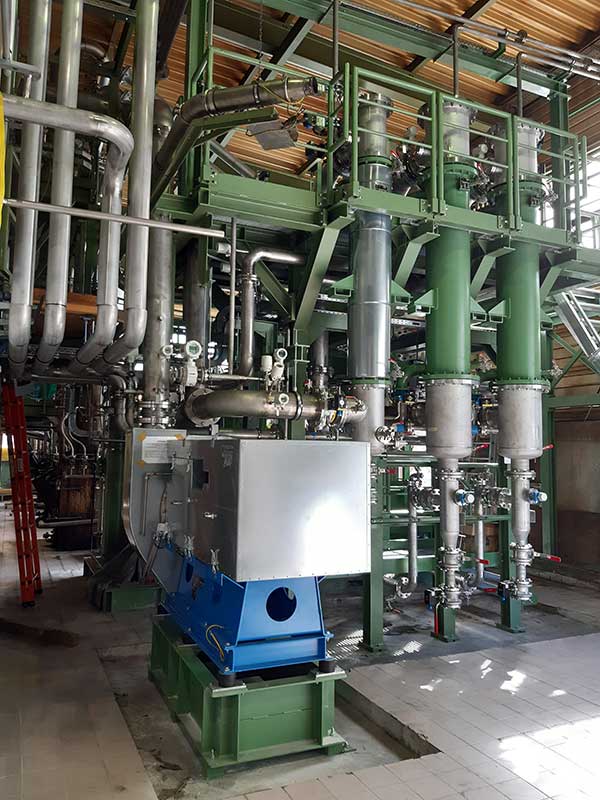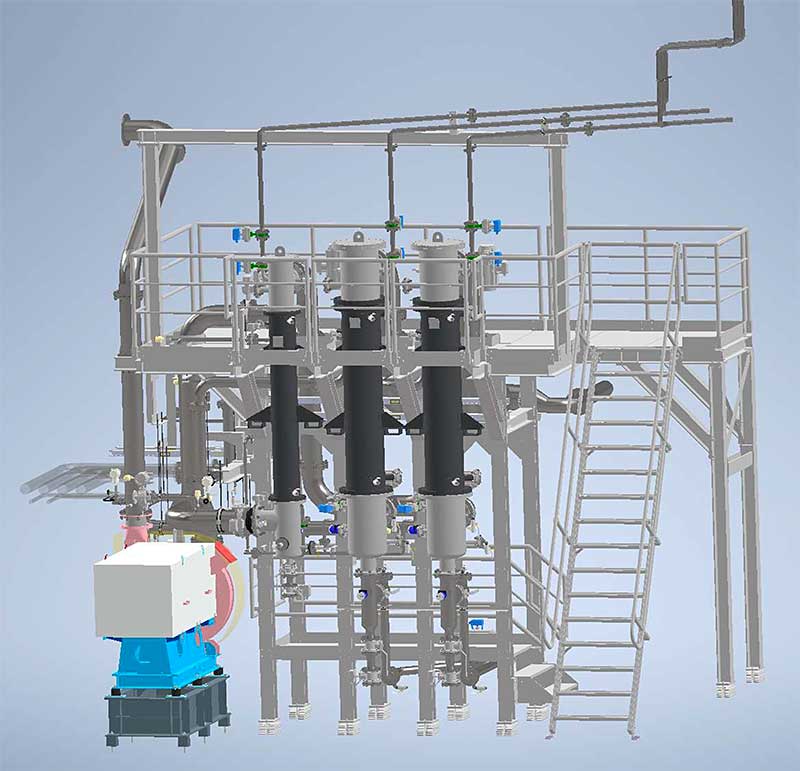Modification of the THEISEN “Clean Gas Distribution System“ installed downstream of several parallel-arranged THEISEN Disintegrator Gas Washers
Our Austria based client operates several furnaces for the treatment of graphite. The CO-/H2 off-gasses are hot and contain tar and dust from the furnace process. During 1997 Theisen GmbH Munich installed three parallel Disintegrator based gas cleaning plants to condition the off-gasses so that these can be used a fuel for other processes or combusted at a flare stack. A particular challenge in this installation is the tar components that are removed from the gas.
Each of the three parallel lines consists of a counter current cooler, a Disintegrator scrubber and a water separator which removes the process water, now containing the captured impurities, from the gas. These three components are mounted on a heated and closed water sump which collects the process water to be recycled back to the process.
An essential portion of the installation is the so called “Clean Gas Distribution System” section where the three parallel process gas streams are collected and routed to either a combustion section or the emergency stack.
The inter connection is based on the variable immersion of the gas ducts into the vessels which in turn are partially immersed in the integrated water sumps. This effectively isolates each of the three up-stream and the downstream systems from each other. By adjusting the immersion depths the downstream clean gas supply flows are controlled.
For the last 20 years the THEISEN Gas Cleaning Plants have been operated without the need for replacements or modifications. Early in 2019 our client appointed THEISEN to modify the “Clean Gas Distribution System” to new requirements, whilst retaining the Theisen Disintegrators gas washers. This modification entailed newly dimensioned vessels and devices installed in an optimized arrangement, as well as the integrated measurement and control instrumentation. Severe time restraints were placed on the available construction time required for the removal of the existing plant and construction of the new plant. Consequently the entire new plant was preassembled on a steel frame which was transported to site. The only remaining site works was the connection to the remaining existing plant.
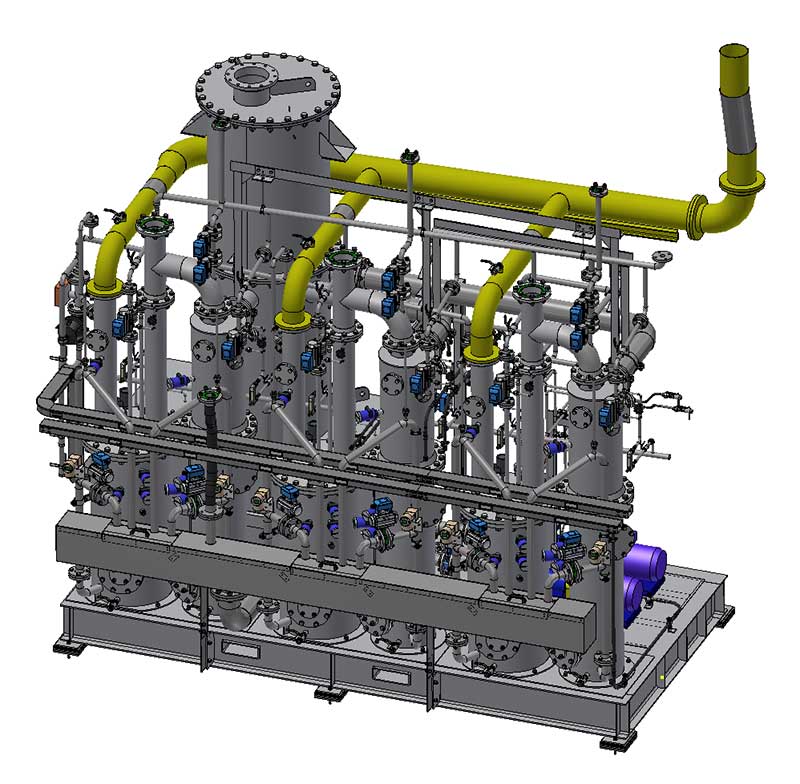
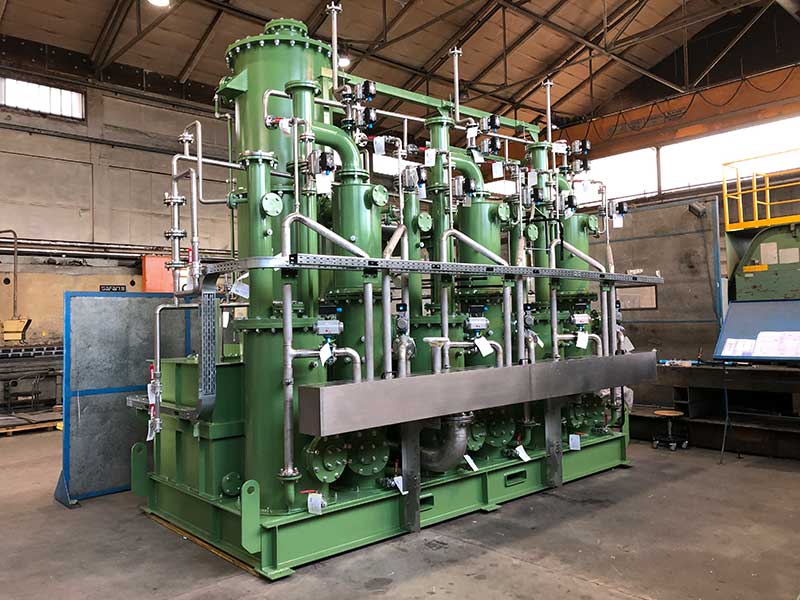
The upgraded THEISEN “Clean Gas Distribution System” was successfully commissioned in October 2019. Since then the new system has been operating absolutely trouble-free.
In 2020 the client appointed Theisen GmbH for the next phase of gas conditioning.
On exiting the Disintegrator scrubbing plant the process gas is water saturated according to its temperature. To prevent condensation of the water vapour in the downstream ducts and desulphurisation section, the moisture content in the process gas must be reduced. Theisen developed a system whereby the process gas is initially cooled to reduce the water vapour content by condensation and then it is reheated. A blower downstream the gas cleaning section drives the process gas via the desulphurisation section to the combustion section.
Two parallel shell and tube coolers provide the required cooling, with one in operation whilst the other is being cleaned. The coolers are in a vertical orientation with gas entry at the top and flowing through the tube bundle. The cooling water enters the shell at the bottom thus forming a counter current flow thus cooling the process gas and allowing a portion of the water vapour to form condensation. The gas and condensation are separated in the lower portion of the cooler with the condensation returning to the sump of the clean gas collector of the gas distributor via a heated pipe and the gas exits laterally. The volume of the cooling water is controlled by a VSD driven cooling water pump.
During the cooling some of the residual tar aerosols condense and are deposited on the tube walls, thus reducing the cooling efficiency over time. Periodically the cooler is taken out of production for cleaning of the internals of the tubes, whilst the standby unit is switched back into production.
Following the cooling process, a shell and tube heat exchanger is used to reheat the process gas thereby lowering its relative humidity. Similarly the gas enters at the top flowing through the tubes, with heating water entering at the bottom of the shell in counter current flow. As there is no more residual tar in the gas, only heat exchanger is required which can also be bypassed if ever required. The volume of the heating water is controlled by a VSD driven water pump.
A blower provides the required pressure increase to draft the gas through the desulphurisation section to the combustion. In future a water filled overflow valve to provide both back flash arrestor and overflow function to the emergency stack is to be installed between the desulphurisation and combustion sections.
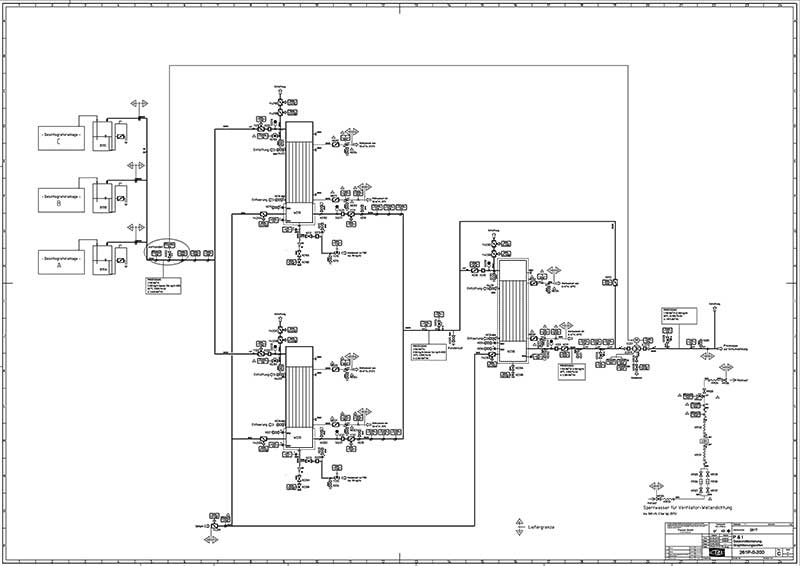
At both of the modified plant sections, all pipes were made of stainless steel. The vessels, ducting, piping, valves and diverse instrumentation were installed in confined area rated ex-zone.
The THEISEN engineered system was manufactured and assembled by Horn GmbH (Ratten/Austria). Close collaboration was required to optimally accommodate the stainless steel piping systems of the various media, i.e. process gas, process water, sealing gas and sealing water in the extremely restricted available space.
